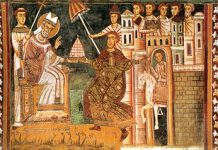Over the past week, Pope Francis has issued not one but two relatively “major” documents, along with the standard fare of other routine Papal speeches, homilies, etc. which come out at the pace of about a document a day, on average. A Catholic who attempts to keep abreast of Papal teaching but has limited time is likely faced with a question:
Should one begin with the encyclical, or the apostolic letter, or skip to the most current angelus address or homily?
As is the case of virtually all papal documents, none of these give definitive teaching, strictly speaking, and the present cornucopia of papal material is overwhelming. The present virtual ineffability of the papal magisterium is not merely a function of Pope Francis seemingly resembling former British Prime Minister, sometime novelist, and indefatigable writer, Benjamin Disraeli, who is said to never have had an unpublished thought. The Vatican website gives one easy access to all three of Pope Francis’ encyclicals—and 87 by Pope Leo XIII if I count correctly (Wikipedia gives a list of 88, as was recounted here in an article by Father Scott Murray a while back, and it would be interesting to know which is missing).
If one does not have the time to read through everything published in the name of the Holy Father (and Church Councils), or even if one does but needs to know where to start, guidance is useful. Lumen Gentium provides some helpful advice for those seeking to give an appropriate “religious submission of mind and will” to the Church’s magisterium. The first paragraph of section 25 of this Dogmatic Constitution teaches that the Pope’s “mind and will in the matter may be known either from the character of the documents, from his frequent repetition of the same doctrine, or from his manner of speaking.”
The character of the document is an important criteria: all things being equal, an encyclical is going to be more important than a Wednesday audience.
Pope Pius XII taught concerning the nature of Encyclical Letters in the encyclical Humani Generis: (August 12, 1950)
What is expounded in the Encyclical Letters of the Roman Pontiffs concerning the nature and constitution of the Church, is deliberately and habitually neglected by some with the idea of giving force to a certain vague notion which they profess to have found in the ancient Fathers, especially the Greeks. The Popes, they assert, do not wish to pass judgment on what is a matter of dispute among theologians, so recourse must be had to the early sources, and the recent constitutions and decrees of the Teaching Church must be explained from the writings of the ancients. . . .
Nor must it be thought that what is expounded in Encyclical Letters does not of itself demand consent, since in writing such Letters the Popes do not exercise the supreme power of their Teaching Authority. For these matters are taught with the ordinary teaching authority, of which it is true to say: “He who heareth you, heareth me”;[3] and generally what is expounded and inculcated in Encyclical Letters already for other reasons appertains to Catholic doctrine. But if the Supreme Pontiffs in their official documents purposely pass judgment on a matter up to that time under dispute, it is obvious that that matter, according to the mind and will of the Pontiffs, cannot be any longer considered a question open to discussion among theologians. (par. 18 and 19)
Does this mean that Leo XIII’s encyclical Affari Vos (On the Manitoba School Question, December 8, 1897) ought to be given higher priority than Pope Francis’ Wednesday Audiences, or John Paul II’s audiences in the early 80’s that became the Theology of the Body? One thing to consider is the addressee, which does pertain, in the words of Vatican II, to the character of the document. Audiences are addressed to those in attendance, though others are free to peruse (or ought to peruse) if they might find the material covered helpful. To whom a document is addressed is, in the language of Vatican II, both part of the character of the document and part of the manner of speaking.
Affari Vos was addressed to the Bishops of Canada in 1897, with an appendix at the end addressed to the press. This is not to say that there are not other people who had some obligation to pay attention—I doubt that Archbishop Duhamel of Ottawa would have been amused to have Sir Wilfred Laurier say that the Pope has written to you, not to me, so his thoughts are not my concern. Even now, those people who find themselves facing questions similar to those of the Manitoba School Question will find reflecting on the teaching of the document helpful, but even in 1897 the vast majority of Catholics would have benefited more from studying other material.
In recent history (from John XXIII on), at least a plurality of encyclicals have been addressed to all Catholics, with the second largest category addressed to everyone. Saint Paul VI’s largely ignored final encyclical, Humanae Vitae (On Human Life, July 25, 1968), was addressed not merely to Catholics but to all men of good will (a common-enough phrase, now). His long forgotten next-to-last encyclical, Sacerdotalis Coelibatus (On Priestly Celibacy, June 24, 1967), was “only” addressed to all Catholics. All Catholics who wonder about celibacy and the priesthood would do well to review St. Paul VI’s teaching in a document that is effectively addressed to them.
The latest encyclical from Pope Francis, Fratelli Tutti, (On Fraternity and Social Friendship, October 3, 2020) is addressed to . . . no one. In some ways, this is not surprising, as the vast majority of Pope Francis’ major documents follow this pattern. Of his encyclicals, only the first is addressed to anyone, and that is addressed to all Catholics. As the latest Apostolic Letter, Scripturae Sacrae Affectus (September 30, 2020), on the sixteen-hundredth anniversay of Saint Jerome, is addressed to no one as well, looking at the addressee is not helpful in deciding where to start.
Both address important subject matter. Pope Francis’ recent encyclical tackles the matter of the second greatest commandment, while the apostolic letter, On the 1600th Anniversary of the Death of St. Jerome, is effectively teaching on Sacred Scripture, and Sacred Scripture is even more important than magisterial teaching.
Encyclicals, and official Papal documents, generally make for difficult reading: while the style in some ways has grown more popular, Pius XI seems to have been the last Pope to recognize that in writing brevity and conciseness are both virtues. At nearly 43,000 words (close to 38,000 if one leaves out footnotes) Francis’ Encyclical is a typical post-Vatican II encyclicals (more than half the length of a doctoral thesis and more than twice the length of the Gospel of Luke, the longest New Testament book). Francis’ Apostolic Letter is only about one-sixth this size. The Encyclical is slightly shorter than Pope Benedict’s Apostolic Exhortation on Scripture, but is longer than all three Scriptural Encyclicals (all pre-Vatican II) and the Vatican II document on Scripture combined. (Caveat lector! – Editor)
The subject matter of the encyclical, how brothers should treat each other, is one that has been subject to debate since shortly after Eve began to homeschool Abel along side Cain, and while the parable of the Good Samaritan and the life of Our Lord provide the definitive words on the topic, it is a fertile field for asking thought-provoking questions with no clear answer. Judging how to imitate the Good Samaritan (or Our Lord) in real life situations often does not lend itself to easy answers.
As Pope Francis, in good Jesuit tradition, loves to try to make people think, the subject matter, along with the length, invokes in me the same sorts of feelings I have when faced with a possible gift of a 5,000 piece jigsaw puzzle. Reading the material in the hermeneutic of continuity is likely to take expertise and much patient effort, which few people have. Some theologians and journalists have already read the material. In deciding whether or not to read the material one’s self, briefer articles will aid one in asking the classic Ignatian question for the discernment of spirits: will this bring peace or disturbance, given my own time and expertise.
On the other hand, Sacred Scripture is a topic that faithful Catholics generally can agree on: God’s revelation is important, and virtually no Catholics would say that they should spend less time studying Sacred Scripture, and few would say that they spend as much as they really ought, perusing and immersing themselves one of God’s greatest gifts. Now having read through the Apostolic Letter three times, I believe that many people could profit from the work. While it is no substitute for drinking from the font of Sacred Writ itself, the Holy Father does provide some valuable insights that may aid some in so drinking, as well as present many older insights, all firmly in the hermeneutic of continuity.
The release of the two documents nearly simultaneously is in a way unfortunate, in that the press and theologians intent on addressing the public square are likely to overlook one that, perhaps, a significant minority of the faithful would actually read and benefit from through direct encounter.
As, in a few months, I will be teaching yet again an Introductory Scripture Course that includes a comprehensive, if brief, survey of major and significant Church documents on Sacred Scripture, analyzing this current teaching from Pope Francis in the light of other Magisterial documents is of immediate concern to me. Here at Catholic Insight, I hope to share further reflections on the document in the upcoming weeks, which may be of use in grappling both with the magisterial teaching and with Sacred Scripture itself.











